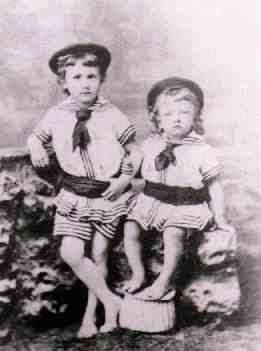
Figure 1.--These French children, George and Paul Charpentier, in their beach costumes for a 1879 photograph. Note the berets. |

|
Clothing for beach resorts and seaside vacations did not just mean swimwear and other casual clothing. Well to do people in the 19th century might bring extensive wardrobes to beach resorts which could be used for strolling along the beach are playing genteel games on the beautifully manicured grounds. And of course one always dressed up for dinner. This began to change as working class people began to take vacations as well. The clothes they wore, while perhaps casual by the convention of the day, seem amazingly formal and heavy to our modern eyes. One of the most popular choices for boys was the white or light-colored sailor suits.
Headwear for the beach was often wide-brimmed hats. Lilly white complexions were very important to the Victorians. It is interesting that protective beachwear has come back into style. The reasons, howeever are quite differet. Today we are concerned about skin cancer caused by over expoure to the sun. In the 19th and early 20th century it was more social. Laborers who worked outside were tanned, not refoned people--especially women. There may have been racial caonntatios as well, but I believe social-class connontations were the most important. Bathing costumes for women by the late 19th century had been simplified to a voile-and-cotton ensembkle covered by a short skirt and completed by long black stockings, low rubber shoes, and an oiled-silk cap. Corsets were no longer required. Patterns were diseminated through patterns published in magazines like Godey's Lady's Book, Peterson's, Demerset's Monthly Magazine and full-scale patterns available that were intoduced by Butterick's in the 1860s. As the turn of the century approached, lighter, short-sleeved bathing suits became fashionable. American ladies preferred light flannels, cottons, linens, and muslins wheras heavier, darker fabrics were preferred in Europe. Harper's Weekly suggested than American women in the 19th century were much more daring than Euroean women. That appears to have changed in the 20th century.
Men wore two piece wool knit suits for swimming. Stripped suits were particularly popular. We care not sure just why. The stripes seem to have conveyed a nautical look. But at beach resorts, men commonly wore formal clothing rather than swim suits. Suits were much more common that actual swim suits, especually before World War I.
I'm afraid I don't have much yet on children's atire at seaside resorts. It is another topic that we hope to eventually research. Actual bathing costumes often had sailor motifs. Poor boys couldn't aford bathing costumes and might go swiming in their underwear. In secluded locations the might go skinny dipping when they were with their mates. However at beach resorts by the Victorian era, bathing costumes were required, even for small children. Not much information yet on bathing costumes, but I am beginning to collect some. Actually beachwear at the turn of the century did not mean just bathing suits. Boys wore the same suits to the beach that they wore for every day. Linnen or other light-weight sailor suits were of course popular outfits for boys on excursions to the beach in the late 19th century. White suits or other light colors (especially pale blue), were especially popular. Of course they were worn with broad-brimmed sailor hats. Broad brimmed hats were especially important for children as they were for women. I am not precisely sure why children often were dressed in wide-brimmed hats. I am not sure that white complexions were quite so important for children, but still they were commonly dressed in broad-brimmed hats. Other suits such as Norfolk suits with stiff Eton collars were also common, often worn with knee pants or knickers and long wollen stockings. This might not sound like sensible beach wear to the modern reader, but don't forget that Victorian England was far removed from the war weather in sunny Florida. Thus English children might be on beach outings on cloddy days with rather cold water--even in July and August. (Take a good look at how far north England is on the map.) So the heavy suits might have felt quite nice. The stiff Eton collars, however, do seem a bit unreasonable--testifying to the more formal approach to dressing which lasted until World War II in America and even longer in England. The children would take off there long stockings to go wadeing and digging on the beach and shallow watter.
Navigate the Boys' Historical Clothing Web Site:
[Return to the Main seaside resort page]
[Introduction]
[Biographies]
[Catalogs]
[Chronology]
[Clothing styles]
[Countries]
[Literary]
[Bibliographies]
[Contributions]
[FAQs]
[Glossaries]
[Images]
[Links]
[Registration]
[Tools]
[Boys' Clothing Home]
Navigate the Boys' Historical Clothing Web Site:
[Sailor suits]
[Sailor hats]
[Buster Brown suits]
[Eton suits]
[Rompers]
[Tunics]
[Smocks]
[Pinafores]
